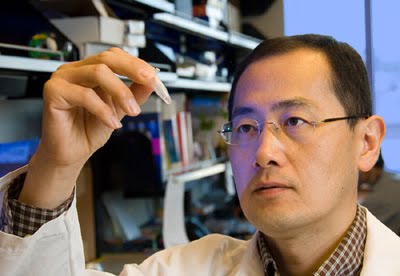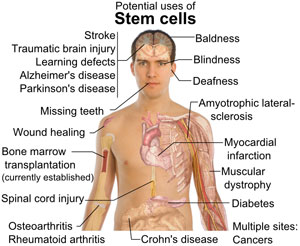Autologous Fat Stem Cells Prevent Acute Rejection of Kidney Grafts
Posted in In the News |
 NEW YORK (Reuters Health) Mar 20 - Kidney transplant patients had a lower risk of rejection and opportunistic infection after inoculation with autologous adipose (fat) mesenchymal stem cells (MSC) than after anti-IL-2 receptor antibody induction therapy, according to a report today in the Journal of the American Medical Association.
"Autologous MSC inoculum was not associated with adverse events nor did it compromise kidney transplant survival," the authors wrote.
Monoclonal antibodies that target interleukin 2-(IL-2) receptors on activated T lymphocytes -- such as basiliximab (Simulect) and daclizumab (Zenapax) -- can reduce acute rejection episodes in kidney recipients.
But Dr. Jianming Tan, of Xiamen University in Fuzhou, China, and colleagues say MSCs may offer an alternative by inhibiting T cell proliferation and suppressing natural killer toxicity, among other immunoregulatory effects.
They tested this strategy in a randomized open-label study of 159 patients receiving a kidney from a living related donor. Patients received either autologous MSCs plus standard-dose or reduced-dose calcineurin inhibitors (CNIs), or basiliximab plus standard-dose CNIs.
Six-month rates of biopsy-proven acute rejection in the two MSC groups were 7.5{99bf78f0f9778281ad05ced5995f1fccf0c60e88939fe5298c3a25dc92a04653} with standard-dose CNIs and 7.7{99bf78f0f9778281ad05ced5995f1fccf0c60e88939fe5298c3a25dc92a04653} with low-dose CNIs, compared with 21.6{99bf78f0f9778281ad05ced5995f1fccf0c60e88939fe5298c3a25dc92a04653} in the basiliximab control group (p=0.02). At 12 months, however, rates of acute rejection were not statistically different at 15.1{99bf78f0f9778281ad05ced5995f1fccf0c60e88939fe5298c3a25dc92a04653}, 17.3{99bf78f0f9778281ad05ced5995f1fccf0c60e88939fe5298c3a25dc92a04653} and 25.5{99bf78f0f9778281ad05ced5995f1fccf0c60e88939fe5298c3a25dc92a04653} in the three groups, respectively.
Renal function recovered more quickly with MSC induction. At seven days posttransplant, the mean estimated glomerular filtration rates (eGFR) in the three groups were 77.0, 74.9 and 52.6 mL/min/1.73 m� (p<0.001), according to the report
Respective rates of opportunistic infection were 18.9{99bf78f0f9778281ad05ced5995f1fccf0c60e88939fe5298c3a25dc92a04653}, 9.6{99bf78f0f9778281ad05ced5995f1fccf0c60e88939fe5298c3a25dc92a04653} and 29.4{99bf78f0f9778281ad05ced5995f1fccf0c60e88939fe5298c3a25dc92a04653} (p=0.03), the authors found.
NEW YORK (Reuters Health) Mar 20 - Kidney transplant patients had a lower risk of rejection and opportunistic infection after inoculation with autologous adipose (fat) mesenchymal stem cells (MSC) than after anti-IL-2 receptor antibody induction therapy, according to a report today in the Journal of the American Medical Association.
"Autologous MSC inoculum was not associated with adverse events nor did it compromise kidney transplant survival," the authors wrote.
Monoclonal antibodies that target interleukin 2-(IL-2) receptors on activated T lymphocytes -- such as basiliximab (Simulect) and daclizumab (Zenapax) -- can reduce acute rejection episodes in kidney recipients.
But Dr. Jianming Tan, of Xiamen University in Fuzhou, China, and colleagues say MSCs may offer an alternative by inhibiting T cell proliferation and suppressing natural killer toxicity, among other immunoregulatory effects.
They tested this strategy in a randomized open-label study of 159 patients receiving a kidney from a living related donor. Patients received either autologous MSCs plus standard-dose or reduced-dose calcineurin inhibitors (CNIs), or basiliximab plus standard-dose CNIs.
Six-month rates of biopsy-proven acute rejection in the two MSC groups were 7.5{99bf78f0f9778281ad05ced5995f1fccf0c60e88939fe5298c3a25dc92a04653} with standard-dose CNIs and 7.7{99bf78f0f9778281ad05ced5995f1fccf0c60e88939fe5298c3a25dc92a04653} with low-dose CNIs, compared with 21.6{99bf78f0f9778281ad05ced5995f1fccf0c60e88939fe5298c3a25dc92a04653} in the basiliximab control group (p=0.02). At 12 months, however, rates of acute rejection were not statistically different at 15.1{99bf78f0f9778281ad05ced5995f1fccf0c60e88939fe5298c3a25dc92a04653}, 17.3{99bf78f0f9778281ad05ced5995f1fccf0c60e88939fe5298c3a25dc92a04653} and 25.5{99bf78f0f9778281ad05ced5995f1fccf0c60e88939fe5298c3a25dc92a04653} in the three groups, respectively.
Renal function recovered more quickly with MSC induction. At seven days posttransplant, the mean estimated glomerular filtration rates (eGFR) in the three groups were 77.0, 74.9 and 52.6 mL/min/1.73 m� (p<0.001), according to the report
Respective rates of opportunistic infection were 18.9{99bf78f0f9778281ad05ced5995f1fccf0c60e88939fe5298c3a25dc92a04653}, 9.6{99bf78f0f9778281ad05ced5995f1fccf0c60e88939fe5298c3a25dc92a04653} and 29.4{99bf78f0f9778281ad05ced5995f1fccf0c60e88939fe5298c3a25dc92a04653} (p=0.03), the authors found.
 Patient survival at one year was 100{99bf78f0f9778281ad05ced5995f1fccf0c60e88939fe5298c3a25dc92a04653}. One graft was lost in the MSC standard-dose CNI group, two in the MSC low-dose CNI group, and one in the control group, Dr. Tan and colleagues report.
They conclude, "In our prospective randomized trial on a large patient population, autologous MSCs could replace anti-IL-2 receptor-induction therapy in living-related donor kidney transplants."
The authors add, "Extended monitoring of study participants will allow assessment of the long-term effects of autologous MSCs on renal allograft function, survival, and safety."
JAMA 2012;307:1169-1177.
Patient survival at one year was 100{99bf78f0f9778281ad05ced5995f1fccf0c60e88939fe5298c3a25dc92a04653}. One graft was lost in the MSC standard-dose CNI group, two in the MSC low-dose CNI group, and one in the control group, Dr. Tan and colleagues report.
They conclude, "In our prospective randomized trial on a large patient population, autologous MSCs could replace anti-IL-2 receptor-induction therapy in living-related donor kidney transplants."
The authors add, "Extended monitoring of study participants will allow assessment of the long-term effects of autologous MSCs on renal allograft function, survival, and safety."
JAMA 2012;307:1169-1177.
 NEW YORK (Reuters Health) Mar 20 - Kidney transplant patients had a lower risk of rejection and opportunistic infection after inoculation with autologous adipose (fat) mesenchymal stem cells (MSC) than after anti-IL-2 receptor antibody induction therapy, according to a report today in the Journal of the American Medical Association.
"Autologous MSC inoculum was not associated with adverse events nor did it compromise kidney transplant survival," the authors wrote.
Monoclonal antibodies that target interleukin 2-(IL-2) receptors on activated T lymphocytes -- such as basiliximab (Simulect) and daclizumab (Zenapax) -- can reduce acute rejection episodes in kidney recipients.
But Dr. Jianming Tan, of Xiamen University in Fuzhou, China, and colleagues say MSCs may offer an alternative by inhibiting T cell proliferation and suppressing natural killer toxicity, among other immunoregulatory effects.
They tested this strategy in a randomized open-label study of 159 patients receiving a kidney from a living related donor. Patients received either autologous MSCs plus standard-dose or reduced-dose calcineurin inhibitors (CNIs), or basiliximab plus standard-dose CNIs.
Six-month rates of biopsy-proven acute rejection in the two MSC groups were 7.5{99bf78f0f9778281ad05ced5995f1fccf0c60e88939fe5298c3a25dc92a04653} with standard-dose CNIs and 7.7{99bf78f0f9778281ad05ced5995f1fccf0c60e88939fe5298c3a25dc92a04653} with low-dose CNIs, compared with 21.6{99bf78f0f9778281ad05ced5995f1fccf0c60e88939fe5298c3a25dc92a04653} in the basiliximab control group (p=0.02). At 12 months, however, rates of acute rejection were not statistically different at 15.1{99bf78f0f9778281ad05ced5995f1fccf0c60e88939fe5298c3a25dc92a04653}, 17.3{99bf78f0f9778281ad05ced5995f1fccf0c60e88939fe5298c3a25dc92a04653} and 25.5{99bf78f0f9778281ad05ced5995f1fccf0c60e88939fe5298c3a25dc92a04653} in the three groups, respectively.
Renal function recovered more quickly with MSC induction. At seven days posttransplant, the mean estimated glomerular filtration rates (eGFR) in the three groups were 77.0, 74.9 and 52.6 mL/min/1.73 m� (p<0.001), according to the report
Respective rates of opportunistic infection were 18.9{99bf78f0f9778281ad05ced5995f1fccf0c60e88939fe5298c3a25dc92a04653}, 9.6{99bf78f0f9778281ad05ced5995f1fccf0c60e88939fe5298c3a25dc92a04653} and 29.4{99bf78f0f9778281ad05ced5995f1fccf0c60e88939fe5298c3a25dc92a04653} (p=0.03), the authors found.
NEW YORK (Reuters Health) Mar 20 - Kidney transplant patients had a lower risk of rejection and opportunistic infection after inoculation with autologous adipose (fat) mesenchymal stem cells (MSC) than after anti-IL-2 receptor antibody induction therapy, according to a report today in the Journal of the American Medical Association.
"Autologous MSC inoculum was not associated with adverse events nor did it compromise kidney transplant survival," the authors wrote.
Monoclonal antibodies that target interleukin 2-(IL-2) receptors on activated T lymphocytes -- such as basiliximab (Simulect) and daclizumab (Zenapax) -- can reduce acute rejection episodes in kidney recipients.
But Dr. Jianming Tan, of Xiamen University in Fuzhou, China, and colleagues say MSCs may offer an alternative by inhibiting T cell proliferation and suppressing natural killer toxicity, among other immunoregulatory effects.
They tested this strategy in a randomized open-label study of 159 patients receiving a kidney from a living related donor. Patients received either autologous MSCs plus standard-dose or reduced-dose calcineurin inhibitors (CNIs), or basiliximab plus standard-dose CNIs.
Six-month rates of biopsy-proven acute rejection in the two MSC groups were 7.5{99bf78f0f9778281ad05ced5995f1fccf0c60e88939fe5298c3a25dc92a04653} with standard-dose CNIs and 7.7{99bf78f0f9778281ad05ced5995f1fccf0c60e88939fe5298c3a25dc92a04653} with low-dose CNIs, compared with 21.6{99bf78f0f9778281ad05ced5995f1fccf0c60e88939fe5298c3a25dc92a04653} in the basiliximab control group (p=0.02). At 12 months, however, rates of acute rejection were not statistically different at 15.1{99bf78f0f9778281ad05ced5995f1fccf0c60e88939fe5298c3a25dc92a04653}, 17.3{99bf78f0f9778281ad05ced5995f1fccf0c60e88939fe5298c3a25dc92a04653} and 25.5{99bf78f0f9778281ad05ced5995f1fccf0c60e88939fe5298c3a25dc92a04653} in the three groups, respectively.
Renal function recovered more quickly with MSC induction. At seven days posttransplant, the mean estimated glomerular filtration rates (eGFR) in the three groups were 77.0, 74.9 and 52.6 mL/min/1.73 m� (p<0.001), according to the report
Respective rates of opportunistic infection were 18.9{99bf78f0f9778281ad05ced5995f1fccf0c60e88939fe5298c3a25dc92a04653}, 9.6{99bf78f0f9778281ad05ced5995f1fccf0c60e88939fe5298c3a25dc92a04653} and 29.4{99bf78f0f9778281ad05ced5995f1fccf0c60e88939fe5298c3a25dc92a04653} (p=0.03), the authors found.
 Patient survival at one year was 100{99bf78f0f9778281ad05ced5995f1fccf0c60e88939fe5298c3a25dc92a04653}. One graft was lost in the MSC standard-dose CNI group, two in the MSC low-dose CNI group, and one in the control group, Dr. Tan and colleagues report.
They conclude, "In our prospective randomized trial on a large patient population, autologous MSCs could replace anti-IL-2 receptor-induction therapy in living-related donor kidney transplants."
The authors add, "Extended monitoring of study participants will allow assessment of the long-term effects of autologous MSCs on renal allograft function, survival, and safety."
JAMA 2012;307:1169-1177.
Patient survival at one year was 100{99bf78f0f9778281ad05ced5995f1fccf0c60e88939fe5298c3a25dc92a04653}. One graft was lost in the MSC standard-dose CNI group, two in the MSC low-dose CNI group, and one in the control group, Dr. Tan and colleagues report.
They conclude, "In our prospective randomized trial on a large patient population, autologous MSCs could replace anti-IL-2 receptor-induction therapy in living-related donor kidney transplants."
The authors add, "Extended monitoring of study participants will allow assessment of the long-term effects of autologous MSCs on renal allograft function, survival, and safety."
JAMA 2012;307:1169-1177.

Recent Comments